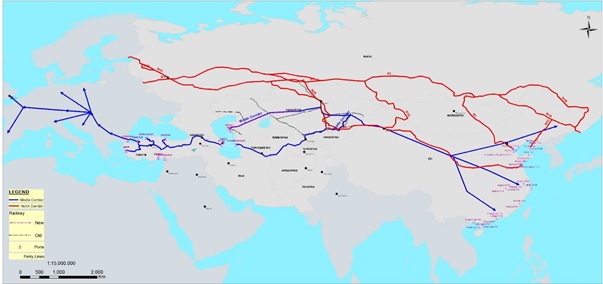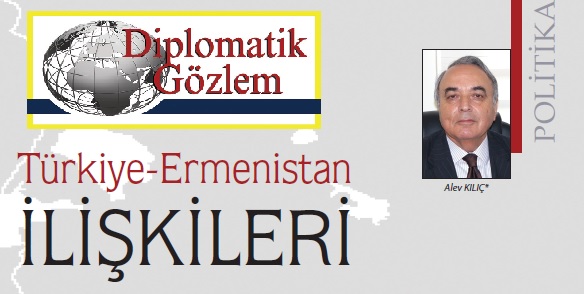
Deniz ÜNVER
Independent Researcher
Central Asia, a strategic region due to its location and rich energy resources, has moved to the limelight. It has various reasons, such as the hydrocarbon reserves or the region being a transit point. In addition, the recent statements of the Chinese President Xi Jinping has attracted attention.
On March 21, Chinese President Xi Jinping stated that a grandiose plan was prepared by Beijing in order to improve relations with Central Asia in his congratulatory Nawruz message to his Tajik Counterpart Emomali Rahmanov[1]. Besides, he expressed that, “The new plan will be presented at the First China-Central Asia Summit in Xian in May[2].” Thus, Beijing and Central Asian countries have compromised on signing additional cooperation agreements in a meeting that will take place next May, called the China+Central Asia Summit, according to Chinese State Media[3]. It was not the first message of President Xi regarding Central Asia. On February 16, Xi conveyed a message to the participants of the First China-Central Asia Forum of Industrial and Investment Cooperation in Tsingtoo, China[4]. He expressed China’s readiness to improve economic relations and cooperation in industry and investment with the countries in Central Asia[5].
It is important to note that the economic influence of Beijing in Central Asia has been increasing for a while. One reason of this is China’s Development and Infrastructure Projects, such as the Belt and Road Initiative (BRI). For a decade, the energy and infrastructure investments of the BRI have turned China into the biggest investor in the region despite the claims that Central Asian countries are becoming dependent on Beijing[6]. Nevertheless, it cannot be denied that the BRI has increased China's economic activity throughout the region by making investment and trade agreements.
The trade level between China and Central Asian Countries has increased significantly recently. Politicians and government officials also mentioned it in their statements. As Chinese Commerce Minister Wang Wentao recently stated, Beijing’s trade volume with the Central Asian countries increased by 22% per cent in the first two months of 2023[7]. Also, Minister Wang added that, “The cross-border e-commerce between China and Central Asia increased by 95 per cent year on year in 2022, and nearly 300 Central Asian enterprises joined China’s e-commerce platforms.[8].” Furthermore, as the American Enterprise Institute’s China Global Investment Tracker declared, China’s 2005-2022 total investments are worth 850$ million in Kyrgyzstan and 1$ billion in Tajikistan.
Moreover, it is noteworthy that the Shanghai Cooperation Organization (SCO), which was initiated in 2001[9], has helped Beijing increase its influence in the region. The Shanghai Cooperation Organization is geared to become a platform to work for China’s vision for a multipolar system and limit Western influence in Asia and the Middle East[10]. In addition to SCO annual security exercises, China, among with Central Asian Countries, perform joint border patrols and military training programs[11]. Thus, it needs particular emphasis that the influence of Chinese private security companies (PSCs), responsible for protecting Chinese personnel and infrastructure in the BRI route, has been increasing in the region. Even it has been commented that the Chinese PSCs stand as a security option when Beijing is not eager to deploy the People’s Liberation Army outside China.[12] As Brianne Todd, a professor at the National Defense University in Washington, claimed, Chinese security activities in the region have significantly increased, especially bilateral and multilateral exercises[13]. Professor Todd also indicated that, “We know that uninformed Chinese personnel are present in Tajikistan, meaning that the Tajik Government has invited them. They are doing everything from border security to counter-terrorism"[14].
Apart from those, China has a military base in Tajikistan. Also, China has a plan to build another military base in Tajikistan. In this sense, it can be argued that China intends to increase its influence in Central Asia through its military activities.
In general, it can be concluded that Beijing has been increasing its influence in the region through its development and infrastructure projects, increasing investments, and making SCO more active in the region through military exercises or joint patrols. In addition to those, the Chinese PSCs' activities contribute to Beijing's influence in Central Asia. Even though Central Asia was known as the backyard of Russia due to the membership to the Collective Security Treaty Organization (CSTO), in particular, this opinion has started to change with the recent activities of China. The influence of Moscow has decreased in the region due to the war in Ukraine. This idea became solid when members of the CSTO declared neutrality on the Russo-Ukrainian War[15]. Yet, it must be remembered that they have refrained from condemning Russia due to the war in Ukraine[16].
*Picture: https://crossroads-ca.org/ccapb1/
[1] John C. K. Daly, “China Unveils Grandiose Plan For Central Asia”, Eurasia Daily Monitor, April 10, 2023, https://jamestown.org/program/china-unveils-grandiose-plan-for-central-asia/
[2] Ibid.
[3] Navbahor Imamova, “China’s Influence in Central Asia Spreads as US Lags”, VOA, April 22, 2023, http://,https://www.voanews.com/a/china-s-influence-in-central-asia-spreads-as-us-lags/7061325.html
[4] John C. K. Daly, “China Unveils Grandiose Plan For Central Asia”, Eurasia Daily Monitor.
[5] Ibid.
[6] Lynne O’Donnell, “It’s a New Great Game. Again.” Foreign Policy, March 20, 2023, https://foreignpolicy.com/2023/03/20/russia-china-competition-central-asia-diplomacy-influence-great-game/
[7] Navbahor Imamova, “China’s Influence in Central Asia Spreads as US Lags”, VOA.
[8] Ibid.
[9] Alessandro Arduino, “Chinese influence in a changing Central Asia”, East Asia Forum, December 15, 2022, https://www.eastasiaforum.org/2022/12/15/chinese-influence-in-a-changing-central-asia/
[10] Ibid.
[11] Ibid.
[12] Ibid.
[13] Navbahor Imamova, “China’s Influence in Central Asia Spreads as US Lags”, VOA.
[14] Ibid.
[15] Saadi Hamidov, “ Central Asia’s Strained Security Architecture”, The Diplomat, April 6, 2023, https://thediplomat.com/2023/04/central-asias-strained-security-architecture/
[16] Ibid.
© 2009-2025 Avrasya İncelemeleri Merkezi (AVİM) Tüm Hakları Saklıdır
Henüz Yorum Yapılmamış.
-
 FURTHER ANALYSIS OF SINO-TURKISH RELATIONS - 10.03.2022
FURTHER ANALYSIS OF SINO-TURKISH RELATIONS - 10.03.2022
Deniz ÜNVER 10.03.2022 -
 G20 ZİRVESİ VE İLETTİĞİ MESAJ - 30.11.2022
G20 ZİRVESİ VE İLETTİĞİ MESAJ - 30.11.2022
Deniz ÜNVER 30.11.2022 -
 G20 AND THE MESSAGE IT CONVEYS - 29.11.2022
G20 AND THE MESSAGE IT CONVEYS - 29.11.2022
Deniz ÜNVER 29.11.2022 -
 MIDDLE CORRIDOR AND ITS POTENTIAL ADVANTAGES - 11.10.2022
MIDDLE CORRIDOR AND ITS POTENTIAL ADVANTAGES - 11.10.2022
Deniz ÜNVER 11.10.2022 -
 BLACK SEA ECONOMIC COOPERATION AND SECURITY IN THE BLACK SEA: IN VIEW OF THE DRONE CONFLICT BETWEEN RUSSIA AND THE US - 24.03.2023
BLACK SEA ECONOMIC COOPERATION AND SECURITY IN THE BLACK SEA: IN VIEW OF THE DRONE CONFLICT BETWEEN RUSSIA AND THE US - 24.03.2023
Deniz ÜNVER 24.03.2023
-
 REMEMBERING SOLINGEN: THE FRACTIOUS RISE OF EXTREME XENOPHOBIA IN WESTERN EUROPE - HÜRRİYET DAILY NEWS - 19.05.2018
REMEMBERING SOLINGEN: THE FRACTIOUS RISE OF EXTREME XENOPHOBIA IN WESTERN EUROPE - HÜRRİYET DAILY NEWS - 19.05.2018
Teoman Ertuğrul TULUN 21.05.2018 -
 HOLLANDA DIŞİŞLERİ BAKANI, OBAMA’YA KARŞI - HÜRRİYET DAILY NEWS - 26.07.2018
HOLLANDA DIŞİŞLERİ BAKANI, OBAMA’YA KARŞI - HÜRRİYET DAILY NEWS - 26.07.2018
Teoman Ertuğrul TULUN 02.08.2018 -
 DOES ARMENIA DESIRE RECONCILIATION WITH TURKEY? - DIPLOMATIC OBSERVER - APRIL 2019
DOES ARMENIA DESIRE RECONCILIATION WITH TURKEY? - DIPLOMATIC OBSERVER - APRIL 2019
Alev KILIÇ 04.04.2019 -
 STRATEJİK SUSKUNLUK: ERMENİLERİN SESSİZLİĞİ (BİRİNCİ BÖLÜM) - 08.2021
STRATEJİK SUSKUNLUK: ERMENİLERİN SESSİZLİĞİ (BİRİNCİ BÖLÜM) - 08.2021
Iver TORIKIAN 15.11.2021 -
 TÜRKİYE-ERMENİSTAN İLİŞKİLERİ
TÜRKİYE-ERMENİSTAN İLİŞKİLERİ
Alev KILIÇ 11.04.2017


